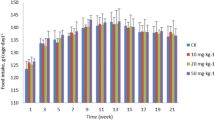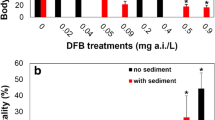Abstract
One of the most common compounds in pesticide formulations, plastics, and papers is 4-nonylphenol (4-NP). It is contained in agricultural, industrial, and wastewater effluents, which when discharged into surface waters affect aquatic fauna. Therefore, the present study aimed to use Biomphalaria alexandrina snails to evaluate the chronic toxicity of 4-NP. Its concentrations in collected water samples from Giza Governorate ranged from 400 to 1600 μg/l. Based on these environmentally relevant concentrations, laboratory experiments were carried out using standard 4-NP to investigate the effect of three concentrations; namely 400, 750, and 1600 μg/l. Survival rate of the exposed snails to 4-NP concentrations was affected after 4 weeks. Reproduction of the exposed snails to 4-NP concentrations was lower than that of the control at 30 °C, while the exposed snails to 400 μg/l of 4-NP showed maximum reproduction at 15 °C. The lowest hatchability percentage was recorded with egg masses laid by the exposed snails to 400 and 1600 μg/l of 4-NP at 15 and 30 °C, respectively. Furthermore, the results showed fluctuated levels of progesterone, estradiol, and testosterone depending upon the concentration and the temperature, which played a key role in determining the degree of 4-NP toxicity.



Similar content being viewed by others
References
Adenusi AA, Odaibo A (2009) Effects of varying concentrations of the crude aqueous and ethanolic extracts of Dalbergia sissoo plant parts on Biomphalaria pfeifferi egg masses. Afr J Tradit Complement Altern Med 6:139–149
Alon G, Shore LS, Steinberger Y (2007) Correlation between levels of sex hormones (progesterone, testosterone, and estrogen) and ecophysiological-behavior stages in two species of desert snails (Sphincterochila zonata and Sphincterochila prophetarum) in the Northern Negev Desert. Gen Comp Endocrinol 151:122–127
Barbosa ND, Pimentel-Souza F, Sampaio IB (1987) The effect of seasonal temperature and experimental illumination on reproductive rate in the snail Biomphalaria glabrata. Braz J Med Biol Res 20:685–696
Benachour N, Moslemi S, Sipahutar H, Seralini GE (2007) Cytotoxic effects and aromatase inhibition by xenobiotic endocrine disrupters alone and in combination. Toxicol Appl Pharmacol 222:129–140
Bennie DT (1999) Review of the environmental occurrence of alkylphenols and alkylphenol ethoxylates. Water Qual Res J 34:79–122
Brooke LT (1993) Acute and chronic toxicity of nonylphenol to ten species of aquatic organisms. Report to the WS. Environmental Protection Agency, Duluth, MN (contract no. 68-C1–0034). Lake Superior Research Institute, University of Wisconsin-Superior, Superior, Wisc
Brooke LT, Thursby G (2005) Aquatic life ambient water quality criteria—nonylphenol. US Environmental Protection Agency (EPA), Office of Water Office of Science and Technology, Washington DC, 88
Cochón AC, Della Penna AB, Kristoff G, Piol MN, De Viale LSM, Guerrero NV (2007) Differential effects of paraquat on oxidative stress parameters and polyamine levels in two freshwater invertebrates. Ecotoxicol Environ Saf 68:286–292
Coutellec MA, Lagadic L (2006) Effects of self-fertilization, environmental stress and exposure to xenobiotics on fitness-related traits of the freshwater snail Lymnaea stagnalis. Ecotoxicol 15:199–213
Czech P, Weber K, Dietrich DR (2001) Effects of endocrine modulating substances on reproduction in the hermaphroditic snail Lymnaea stagnalis L. Aquat Toxicol 53:103–114
de Freitas Tallarico L, Borrely SI, Hamada N, Grazeffe VS, Ohlweiler FP, Okazaki K, Granatelli AT, Pereira IW, de Bragança Pereira CA, Nakano E (2014) Developmental toxicity, acute toxicity and mutagenicity testing in freshwater snails Biomphalaria glabrata (Mollusca: Gastropoda) exposed to chromium and water samples. Ecotoxicol Environ Saf 110:208–215
Ducrot V, Askem C, Azam D, Brettschneider D, Brown R, Charles S, Coke M, Collinet M, Delignette-Muller ML, Forfait-Dubuc C, Holbech H (2014) Development and validation of an OECD reproductive toxicity test guideline with the pond snail Lymnaea stagnalis (Mollusca, Gastropoda). Regul Toxicol Pharmacol 70:605–614
Duft M, Schulte-Oehlmann U, Weltje L, Tillmann M, Oehlmann J (2003) Stimulated embryo production as a parameter of estrogenic exposure via sediments in the freshwater mudsnail Potamopyrgus antipodarum. Aquat Toxicol 64:437–449
EPA US (2005) Aquatic life ambient water quality criteria—nonylphenol. EPA-822-R-05
EU European Union Risk Assessment Report (2002) 4-Nonylphenol (branched) and nonylphenol. 2nd priority list volume: 10Assessment ER. 4-Nonylphenol (branched) and Nonylphenol.”European Commission. Institute for Health and Consumer Protection, European Chemicals Bureau
Giusti A, Ducrot V, Joaquim-Justo C, Lagadic L (2013) Testosterone levels and fecundity in the hermaphroditic aquatic snail Lymnaea stagnalis exposed to testosterone and endocrine disruptors. Environ Toxicol Chem 32:1740–1745
Goupy P, Hugues M, Boivin P, Amiot MJ (1999) Antioxidant composition and activity of barley (Hordeum vulgare) and malt extracts and of isolated phenolic compounds. J Sci Food Agric 79:1625–1634
Hammond B, Katzenellenbogen BS, Krauthammer N, McConnell J (1979) Estrogenic activity of the insecticide chlordecone (Kepone) and interaction with uterine estrogen receptors. Proc Nat Acad Sci 76:6641–6645
Haszprunar G, Wanninger A (2012) Molluscs. Curr Biol 22:510–514
Hathaway JJ, Adema CM, Stout BA, Mobarak CD, Loker ES (2010) Identification of protein components of egg masses indicates parental investment in immunoprotection of offspring by Biomphalaria glabrata (Gastropoda, Mollusca). Dev Comp Immunol 34:425–435
Heugens EH, Hendriks AJ, Dekker T, Straalen NMV, Admiraal W (2001) A review of the effects of multiple stressors on aquatic organisms and analysis of uncertainty factors for use in risk assessment. Crit Rev Toxicol 31:247–284
Holmstrup M, Bindesbøl AM, Oostingh GJ, Duschl A, Scheil V, Köhler HR, Loureiro S, Soares AM, Ferreira AL, Kienle C, Gerhardt A (2010) Interactions between effects of environmental chemicals and natural stressors: a review. Sci Total Environ 408:3746–3762
Hooper MJ, Ankley GT, Cristol DA, Maryoung LA, Noyes PD, Pinkerton KE (2013) Interactions between chemical and climate stressors: a role for mechanistic toxicology in assessing climate change risks. Environ Toxicol Chem 32:32–48
Jessica D, Robert M, Frédéric S, Arnaud B, Delphine L, Jean-Pierre T, Patrick K (2007) Do sewage treatment plant discharges substantially impair fish reproduction in polluted rivers. Sci Total Environ 372:497–514
Jobling S, Sumpter JP, Sheahan D, Osborne JA, Matthiessen P (1996) Inhibition of testicular growth in rainbow trout (Oncorhynchus mykiss) exposed to estrogenic alkylphenolic chemicals. Environ Toxicol Chem 15:194–202
Kimberly DA, Salice CJ (2014a) Complex interactions between climate change and toxicants: evidence that temperature variability increases sensitivity to cadmium. Ecotoxicol 23:809–817
Kimberly DA, Salice CJ (2014b) If you could turn back time: understanding transgenerational latent effects of developmental exposure to contaminants. Environ Pollut 184:419–425
Kristoff G, Guerrero NRV, Cochón AC (2010) Inhibition of cholinesterases and carboxylesterases of two invertebrate species, Biomphalaria glabrata and Lumbriculus variegatus, by the carbamate pesticide carbaryl. Aquat Toxicol 96:115–123
Kubiriza GK, Madsen H, Likongwe JS, Stauffer JR, Kang'Ombe J, Kapute F (2010) Effect of temperature on growth, survival and reproduction of Bulinus nyassanus (Smith, 1877) (Mollusca: Gastropoda) from Lake Malawi. Afr Zool 45:315–320
Lahlou M (2004) Study of the molluscicidal activity of some phenolic compounds: structure-activity relationship. Pharm Biol 42:258–261
Madigou T, Le Goff P, Salbert G, Cravedi JP, Segner H, Pakdel F, Valotaire Y (2001) Effects of nonylphenol on estrogen receptor conformation, transcriptional activity and sexual reversion in rainbow trout (Oncorhynchus mykiss). Aquat Toxicol 53:173–186
Marie MA, El-Deeb FA, Hasheesh WS, Mohamed RA, Sayed SSM (2015) Impact of seasonal water quality and trophic levels on the distribution of various freshwater snails in four Egyptian governorates. Appl Ecol Environ Sci 3:117–126
McCreesh N, Arinaitwe M, Arineitwe W, Tukahebwa EM, Booth M (2014) Effect of water temperature and population density on the population dynamics of Schistosoma mansoni intermediate host snails. Parasit Vectors 7:503
McLachlan JA (1993) Functional toxicology: a new approach to detect biologically active xenobiotics. Environ Health Perspect 101:386–387
Metcalfe CD, Hoover L, Sang S (1996) Nonylphenol ethoxylates and their use in Canada. Report to the World Wildlife Fund Canada, pp 1–33
Naokuni T (1979) Induction of egg-laying by steroid hormones in slugs. Comp Biochem Physiol A Physiol 62:273–278
Nduku WK, Harrison AD (1980) Cationic responses of organs and haemolymph of Biomphalaria pfeifferi (Krauss), Biomphalaria glabrata (Say) and Helisoma trivolvis (Say) (Gastropoda: Planorbirdae) to cationic alterations of the medium. Hydrobiol 68:119–138
OECD (Organization for Economic Cooperation and Development) (2010) Detailed review paper (DRP) on molluscs life-cycle toxicity testing. OECD 830 series on testing and assessment no. 121, OECD, Paris, France
Oketola AA, Fagbemigun TK (2013) Determination of nonylphenol, octylphenol and bisphenol-A in water and sediments of two major rivers in Lagos, Nigeria. J Environ Prot 4:38–45
Oliveira-Filho EC, Grisolia CK, Paumgartten FJR (2009) Trans-generation study of the effects of nonylphenol ethoxylate on the reproduction of the snail Biomphalaria tenagophila. Ecotoxicol Environ Saf 72:458–465
Olivier L, Haskins WT (1960) The effects of low concentrations of sodium pentachlorophenate on the fecundity and egg viability of Australorbis glabratus. Am J Trop Med Hyg 9:199–205
Rizk MZ, Metwally NS, Hamed MA, Mohamed AM (2012) Correlation between steroid sex hormones, egg laying capacity and cercarial shedding in Biomphalariaalexandrina snails after treatment with Haplophyllum tuberculatum. Exp Parasitol 132:171–179
Santos MM, Castro LF, Vieira MN, Micael J, Morabito R, Massanisso P, Reis-Henriques MA (2005) New insights into the mechanism of imposex induction in the dogwhelk Nucella lapillus. Comp Biochem Physiol Part C: Toxicol Pharmacol 141:101–109
Seppälä O, Jokela J (2011) Immune defence under extreme ambient temperature. Biol Lett 7:119–122
Servos MR (1999) Review of the aquatic toxicity, estrogenic responses and bioaccumulation of alkylphenols and alkylphenol polyethoxylates. Water Qual Res J 34:123–178
Sharpe RM, Fisher JS, Millar MM, Jobling S, Sumpter JP (1995) Gestational and lactational exposure of rats to xenoestrogens results in reduced testicular size and sperm production. Environ Health Perspect 103:1136–1143
Simpson ER, Mahendroo MS, Means GD, Kilgore MW Hinshelwood MM, Graham-Lorence S, Amarneh B, Ito T, Fisher CR, Michael MD, Mendelson CR (1994) Aromatase cytochrome P450, the enzyme responsible for estrogen biosynthesis. End Rev 15:342–355
Sternberg RM, Hotchkiss AK, LeBlanc GA (2008) The contribution of steroidal androgens and estrogens to reproductive maturation of the eastern mud snail Ilyanassa obsoleta. Gen Comp Endocrinol 156:15–26
Takeda N (1977) Stimulation of egg-laying by nerve extracts in slugs. Nature 267(5611):513–514
Watanabe H, Suzuki A, Goto M, Lubahn DB, Handa H, Iguchi T (2004) Tissue-specific estrogenic and non-estrogenic effects of a xenoestrogen, nonylphenol. J Mol Endocrinol 33:243–252
White R, Jobling S, Hoare SA, Sumpter JP, Parker MG (1994) Environmentally persistent alkylphenolic compounds are estrogenic. Endocrinol 135:175–182
Author information
Authors and Affiliations
Corresponding author
Ethics declarations
Conflict of interest
The authors declare that they have no conflict of interest.
Additional information
Responsible editor: Philippe Garrigues
Publisher’s note
Springer Nature remains neutral with regard to jurisdictional claims in published maps and institutional affiliations.
Rights and permissions
About this article
Cite this article
Abdel–Wareth, M.T.A., Sayed, S.S.M. Reprotoxicity of 4-nonylphenol to Biomphalaria alexandrina snails at certain temperatures. Environ Sci Pollut Res 26, 18533–18540 (2019). https://doi.org/10.1007/s11356-019-05142-w
Received:
Accepted:
Published:
Issue Date:
DOI: https://doi.org/10.1007/s11356-019-05142-w




